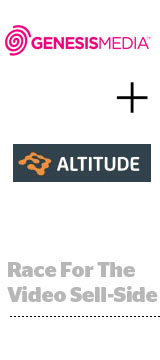
Genesis Media revealed Thursday that it has merged with video ad platform Altitude Digital.
The combined entity will do business as Genesis Media. Details of the transaction were not disclosed.
The merger comes months after Altitude’s former CEO stepped down. The company, which started out as an ad net, was seeking to reposition itself as a publisher-focused SSP, emphasizing quality inventory as more ad buyers demand premium video.
Mark Yackanich will continue to serve as Genesis Media’s CEO, while Altitude Digital’s recently appointed CEO Joe Grover, an early VC investor in Altitude Digital, assumes the role of president and CMO of Genesis Media.
Genesis Media, which historically competed with outstream ad networks like Teads, had aimed to differentiate its platform by creating “attention” analytics around how consumers interact with a video ad, how long they viewed and in what context the video ad appeared.
Because its technology can be embedded with the publisher’s CMS, it’s able to score ads and related editorial content based on 400 or more attributes, like active time spent or rate of abandonment.
“Publishers and editorial are often looking at data around what’s driving traffic and how users are interacting and how engaged they are, but that very rarely gets blended into programmatic advertising,” Grover said, adding that programmatic activations sometimes prioritize finding the right audience over placing ads next to quality content.
One outcome of the merger will be Genesis’ ability to combine its content and user behavior analytics with Altitude’s programmatic capabilities in one unified offering for publishers, Grover said.
“The industry has heard very clearly from P&G and others that having an impression is not enough,” Yackanich added. “But creating impressions that have a lot of value – that’s hard and requires investment on the part of the publisher.”
Another motivation for the merger is creating more scale, as the combined company will increase its direct publisher relationships. Although Genesis didn’t share how many clients it’s adding to its roster, the merger will double the size of its team and engineering resources, according to Yackanich.
This growth will specifically help Genesis address the video scarcity problem.
“We thought there was a lot of value to be added not just by creating video ad units and putting them everywhere, but by applying a layer of intelligence to the creation of that inventory,” Yackanich said. “With this merger, we’ll be in a position to really scale that pursuit.”
But Genesis’ and Altitude’s merger also points to the ongoing consolidation in the ad network space as publishers prioritize direct relationships and exchange-traded media, which Altitude was not immune to.
Grover’s former VC firm Mercato Partners led a Series A investment into Altitude in 2013, when it was a much smaller company that was maniacally focused on growth.
“Now, the market’s in a place where maybe a company has a lot of cash but doesn’t add value to the ecosystem or it’s a half-baked technology platform looking for a soft landing,” he acknowledged. “There’s a lot of selling going on.”
Altitude’s investors essentially gave it two choices: To sell as a stand-alone company or double down, develop a real technology platform that addressed key market needs and drive profitability, not just growth.
It opted for the latter.
“We decided to double down, given the pressure and weakness in the market,” Grover said. “I believe fully this is a period where we will see intermediaries pushed out over the next 12 to 18 months.”
This post was syndicated from Ad Exchanger.

More Stories
New CEO for Bastion ANZ
A Life in 3 Minutes: Swedish Lingerie Brand Debuts an Emotion-Packed Ad
Go Media becomes Toitū net carbonzero certified